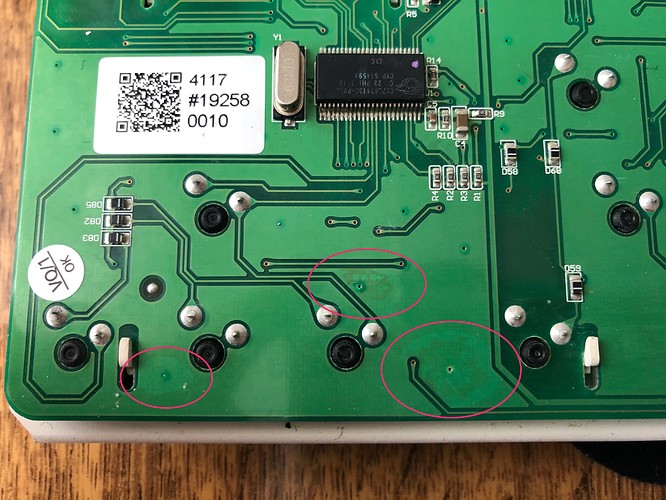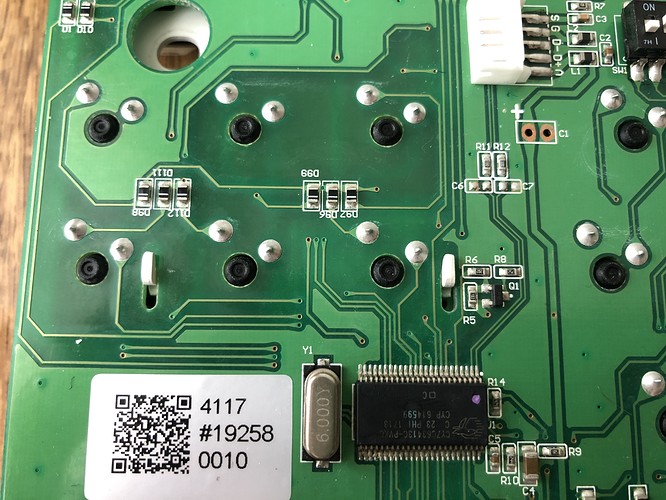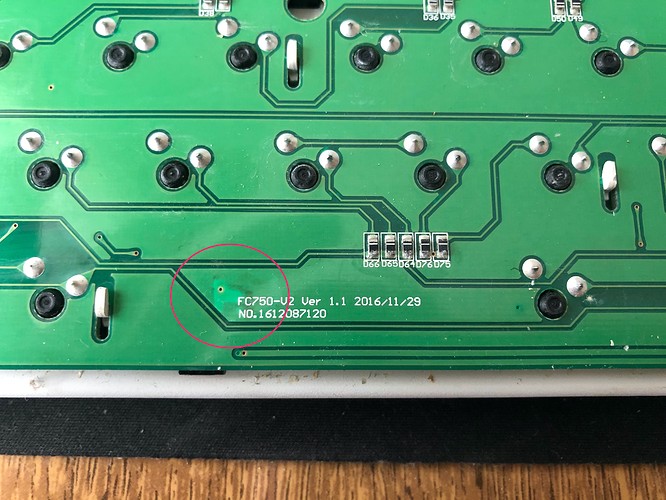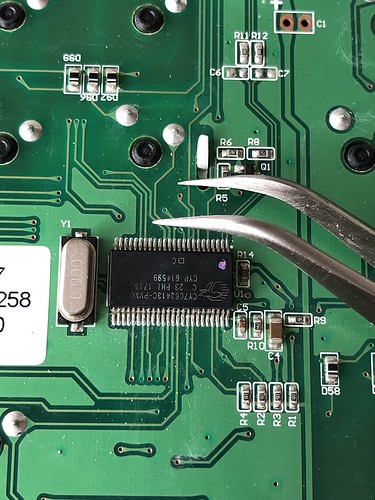I spilled a cup of tea on my Leopold fc750r and got corrosion in several places on the PCB. After I disassembled kb and dried everything, I got about 6 pairs of keys which are always pressed simultaneously (the most annoying are “b4”, “n7”, “/0”).
Now does anyone has an experience of repairing that kind of failure? Any help would be appreciated.
I don’t think what you circled in red are the cause of the problem: those are stitching vias that connect upper ground plane to the lower ground plane.
Are those switches registering even if you don’t press them ?
There may be hope that none of the MCU pins are dead, in this case probably only the switches themselve are faulty.
Do you have a multimeter ?
Do you have a multimeter ?
Yes, I do
Are those switches registering even if you don’t press them ?
There may be hope that none of the MCU pins are dead, in this case probably only the switches themselve are faulty.
Yes, Karabiner EventViewer shows, that events from both keys comes to the computer, regardless of which exactly I’ve pressed. That leads me to the conclusion that PCB itself became faulty.
@Rico, what do you suggest to check with multimeter?
Its most likely the coffee forming a bridge in one or more spots on the PCB.
It should be fixable. You can try washing the back of the PCB with rubbing alcohol letting it try and trying again. If that doesn’t work you might need to desolder all the switches and disassemble the whole board. You could start with the just the offending switches to see if that stops them from being pressed.
Just a thought, 6 keys is usually a default max number of keys passed over usb simultaneously so you might end up in a whac-a-mole scenario.
I’m not sure I understand the meaning of “rubbing alcohol”. I washed it with Wurth Brake Cleaner.
Just a thought, 6 keys is usually a default max number of keys passed over usb simultaneously so you might end up in a whac-a-mole scenario.
Seems that you misunderstood me: there are several pairs of keys, such that when I press one key from the pair - event from another key from that pair is also registered.
Again, that doesn’t seem to me to be the switch problem. Could you please convince me, @Dave, if you think that I’m wrong?
You can use isopropyl alcohol. I usually call it rubbing alcohol but to be honest I am not sure if there is a difference. I have never tried something break cleaner for this purpose. I am not saying it can’t be done I just haven’t tried it.
I don’t think it is a switch problem either. My thoughts are it is likely something causing a bridge in the row column matrix of the PCB which is why you see that pairing of keys (so there is a bridge between row 2 and row 5 in your case for those particular columns). Perhaps by removing a few of the offending switches it might help to see if there is anything that can be cleaned from the top of the PCB but it is kind of a guessing game.
I have taken out switches on a Leopold it is very time consuming I don’t blame you for trying to avoid doing it. Perhaps someone else might have a better idea.
@Dave is right.
So the good news is that most probably your MCU is fine.
The bad news is that you will have to desolder switches to clean the mess.
As I’m quite used to this process I would desolder everything to clean the top side of the PCB cleanly.
But it is a time consuming process and you need to have a good desoldering pump.
I made an explanation of the process in this forum at the following link:
Thanks for your thoughts guys, I will try to do the cleanup on weekends, because I don’t have a replacement kb.
You have some serious corrosion on the mcu. I own quite a few leopolds and none of the solders look like your mcu does.
Yeah, thats because I’ve spilled a whole cup of tea on it.
Just for the record: with lemon, no sugar. So the corrosion may be a result of a reaction with citric acid.
A lot of good advice and observations so far. 
I would get a cheap toothbrush and some cleaning alcohol and brush the residue off the MCU pins and all the surface mounted diodes.
I wouldn’t bother doing in-circuit testing with a multimeter unless I understand the circuit, so that would be far down on my troubleshooting list.
Do report back – we’re all curious! 
Sure I will
The only problem here is that alcohol doesn’t dissolve those oxides(salts), and toothbrush wont brush them off. Will need something more efficient.
Maybe gently rubbing between the pins with a wooden toothpick…
Sure, trust your handyman instincts here and try something else. As long as the important parts stay where they belong … 
If you can not wash the corrosion off the MCU a quick drag solder across the MCU pins using flux might help clean it off & replace it with fresh solder. Although I do not recommend trying this unless you have experience with drag soldering.
Thanks all guys, the keyboard is working finally. The glitches had gone after I removed corrosion between MCU pins. I’m so happy I didn’t have to desolder anything at all 
Great news!
What did you used for the cleaning process?



